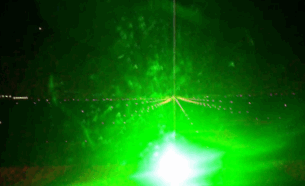@randomlugia, I've seen the PPT where that picture came from. It is a simulation of a picture taken with a camera. I've done my own tests: looked into the beam of a 250mW LPC-815 with bare eyes, from 5m away


of course there's a trick to it: I've DEFOCUSED the beam to a diameter of about 70cm, simulating how it would look like from about 1500m distance (I've calculated the parameters in advance and knew there was no danger, even then I first wore sunglasses). Taking the differences in power, wavelength, and distance into account, I'd say the picture looks about right, except that the eye would not see the overpowering white spot in the middle - visibility would not be quite as poor around the laser beam.
Of course, someone shining a laser at a plane from this vantage point would have to be very close to the runway - most likely within the airport perimeter. In that sense it is not representative of actual laser incidents.
Somebody who owns a gun knows it is for killing, so a hunter shooting at an aircraft certainly has a different motivation than someone shining a laser. Most people who own lasers, including the ones here, just know how the beam looks (weak, in most cases it has to be rather dark before you even see it), or the spot (very bright up close when focusing for burning, interestingly bright if you shine it at a wall a couple 100 feet away, but nothing you'd think twice about looking at). But who knows what it looks like to look
into the beam from a large distance? Well I do, but who else ever even thought about actually doing this experiment? (Even the makers of the FAA study used just a simulation!) I've no doubt that the people shining lasers at an airplane have no idea that the effect is fundamentally different from doing the same with a high-power flashlight.
No, I don't propose people should go ahead and point laser beams at airplanes (to forestall some knee-jerk reactions). I don't even propose people throw stones at planes. But hysteria is not the answer either. Education is - on all sides.




